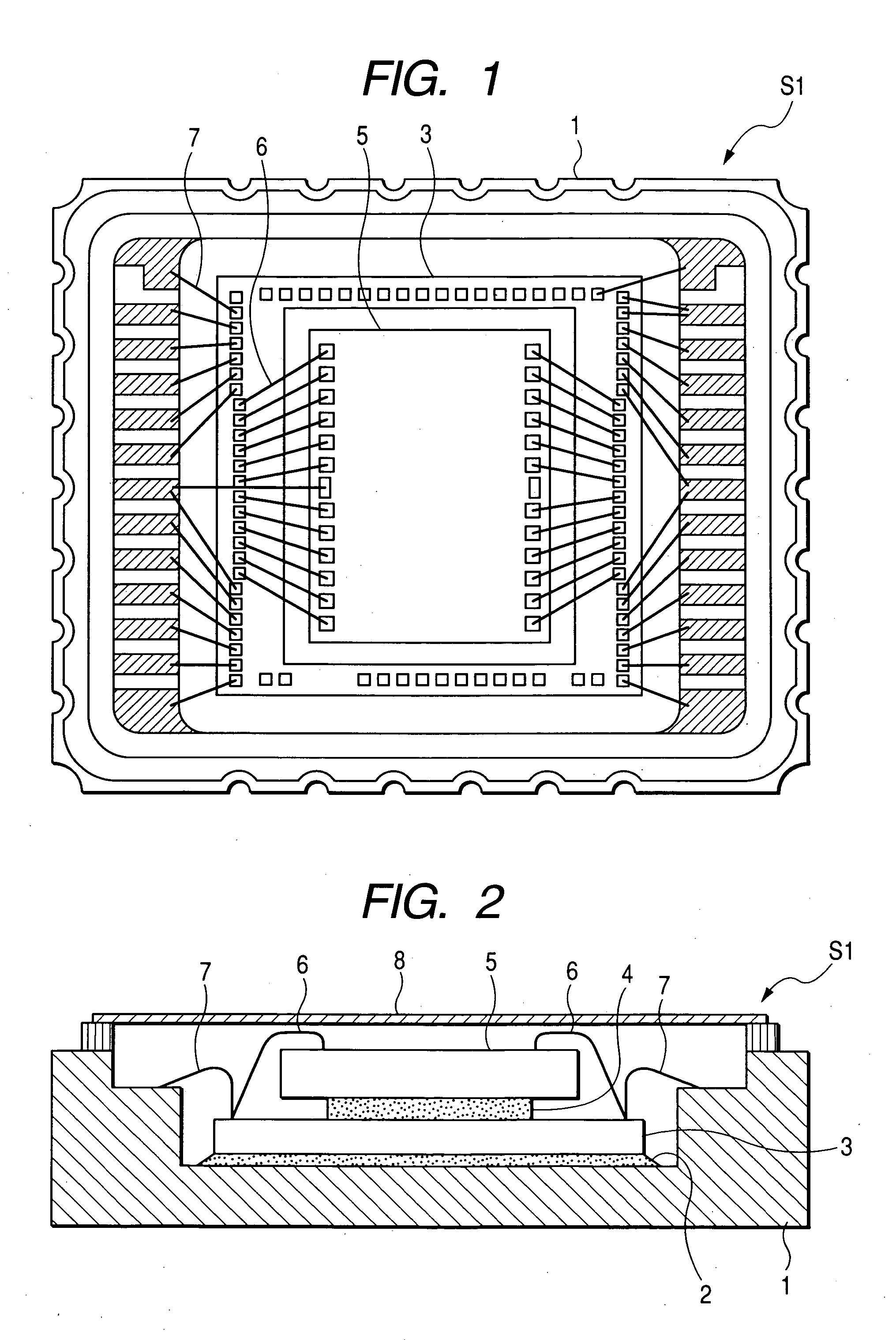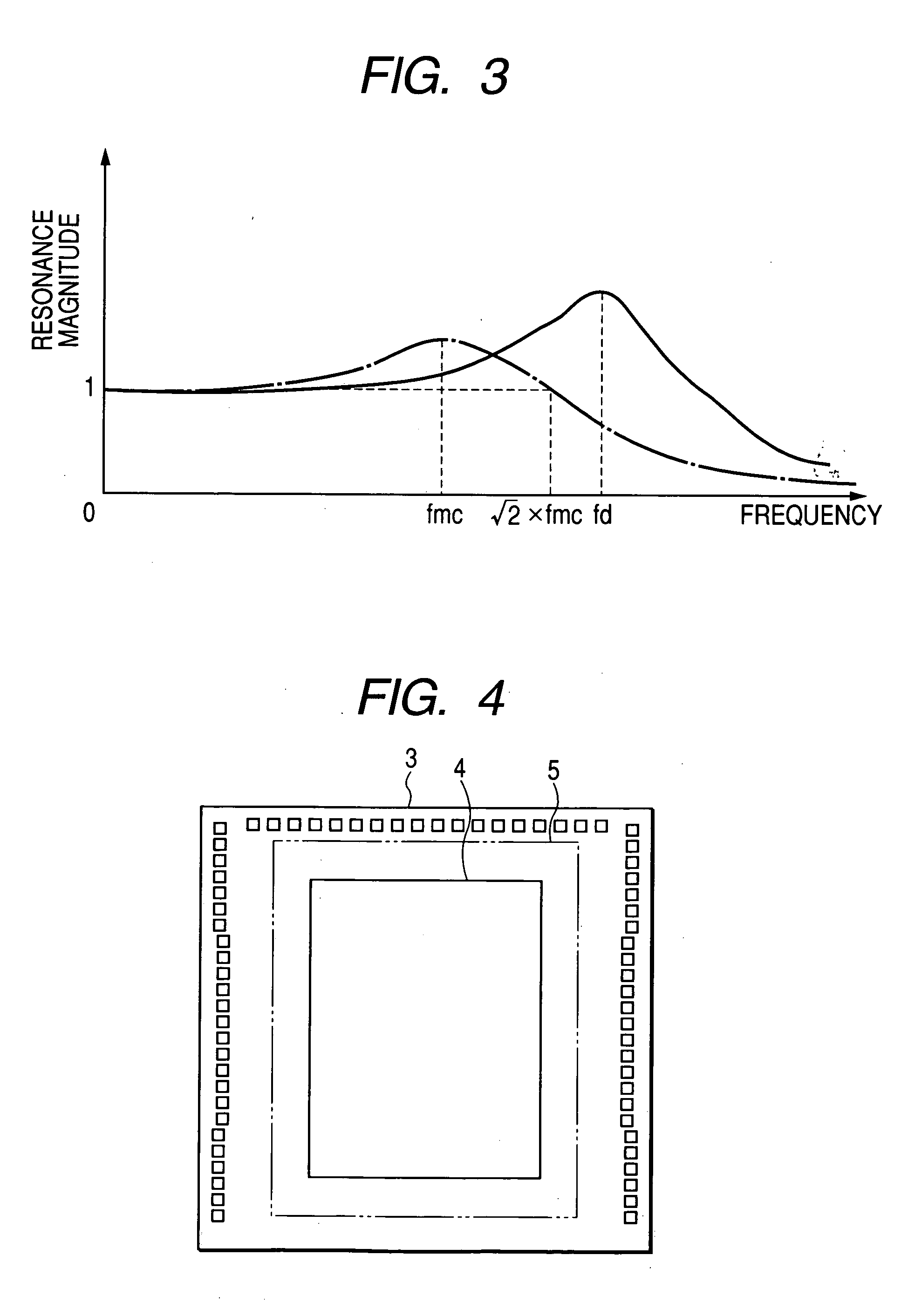Vibration-type angular rate sensor
a technology of angular rate sensor and vibration, which is applied in the direction of acceleration measurement using interia force, turn-sensitive devices, instruments, etc., can solve the problems of increased manufacturing costs, increased processing costs, and inability to detect angular velocity accurately, so as to improve prevent the resonance point in the rotation mode from lowering, and secure the vibration-proof properties of the sensor chip
- Summary
- Abstract
- Description
- Claims
- Application Information
AI Technical Summary
Benefits of technology
Problems solved by technology
Method used
Image
Examples
first embodiment
[0028] Hereinafter, a first embodiment of the present invention will be explained with reference to FIGS. 1 to 5.
[0029]FIG. 1 is a plan view and FIG. 2 is a cross-sectional view, each showing an angular rate sensor S1 in accordance with a first embodiment of the present invention. As shown in FIGS. 1 and 2, the angular rate sensor S1 includes a ceramic package 1 which arranges a base portion of the sensor S1. The sensor S1 is attached to an appropriate portion of a member to be measured. A circuit chip 3 is mounted on a bottom of the ceramic package 1 and fixed there with an adhesive 2.
[0030] A boding portion, defining a region where the sensor chip 5 is mounted, is provided on an upper surface of the circuit chip 3. A sensor chip 5 is laminated on this boding portion via an adhesive film 4. According to this embodiment, the adhesive film 4 is a silicone-group film which has lower elasticity and appropriate viscoelastic characteristics.
[0031] The sensor chip 5 and the circuit chi...
second embodiment
[0046] Next, a second embodiment of the present invention will be explained with reference to FIGS. 6 to 9. The second embodiment is different from the above-described first embodiment in that adhesive film 4 is separated or divided into a plurality of adhesive film portions.
[0047] The above-described first embodiment can improve the vibration-proof properties. However, in the case that the area of adhesive film 4 is reduced at only one point corresponding to the central region of the sensor chip 5, the resonance point of the rotation mode in the sensor chip 5 will decrease. More specifically, when an angular velocity is applied around a rotation axis, the rotational force is transmitted along the route of package 1→circuit chip 3→sensor chip 5. In the case that reducing the area of the adhesive film 4 is performed at only one point corresponding to the central region of the sensor chip 5, the bonding portion between the circuit chip 3 and the sensor chip 5 is positioned closely to...
third embodiment
[0053] Next, a third embodiment of the present invention will be explained with reference to FIGS. 10 and 11. The third embodiment is different from the above-described first embodiment in that the sensor chip 5 includes two oscillators.
[0054]FIGS. 10 and 11 are plan views showing practical examples of plural adhesive film portions 4a and 4b formed on a circuit chip in accordance with a third embodiment of the present invention. According to the third embodiment of the present invention, the sensor chip 5 has two dissected oscillators 5a and 5b disposed in such a manner that their acceleration detecting sensitivities can be cancelled. From the view point of relaxing the thermal stresses acting on respective oscillators 5a and 5b, two adhesive film portions 4a and 4b are bonded so as to agree at their centers with the rotation axes (i.e. Z axes) of respective oscillators 5a and 5b as shown in FIGS. 10 and 11. According to this arrangement, the thermal stresses acting on respective o...
PUM
 Login to View More
Login to View More Abstract
Description
Claims
Application Information
 Login to View More
Login to View More - R&D
- Intellectual Property
- Life Sciences
- Materials
- Tech Scout
- Unparalleled Data Quality
- Higher Quality Content
- 60% Fewer Hallucinations
Browse by: Latest US Patents, China's latest patents, Technical Efficacy Thesaurus, Application Domain, Technology Topic, Popular Technical Reports.
© 2025 PatSnap. All rights reserved.Legal|Privacy policy|Modern Slavery Act Transparency Statement|Sitemap|About US| Contact US: help@patsnap.com



